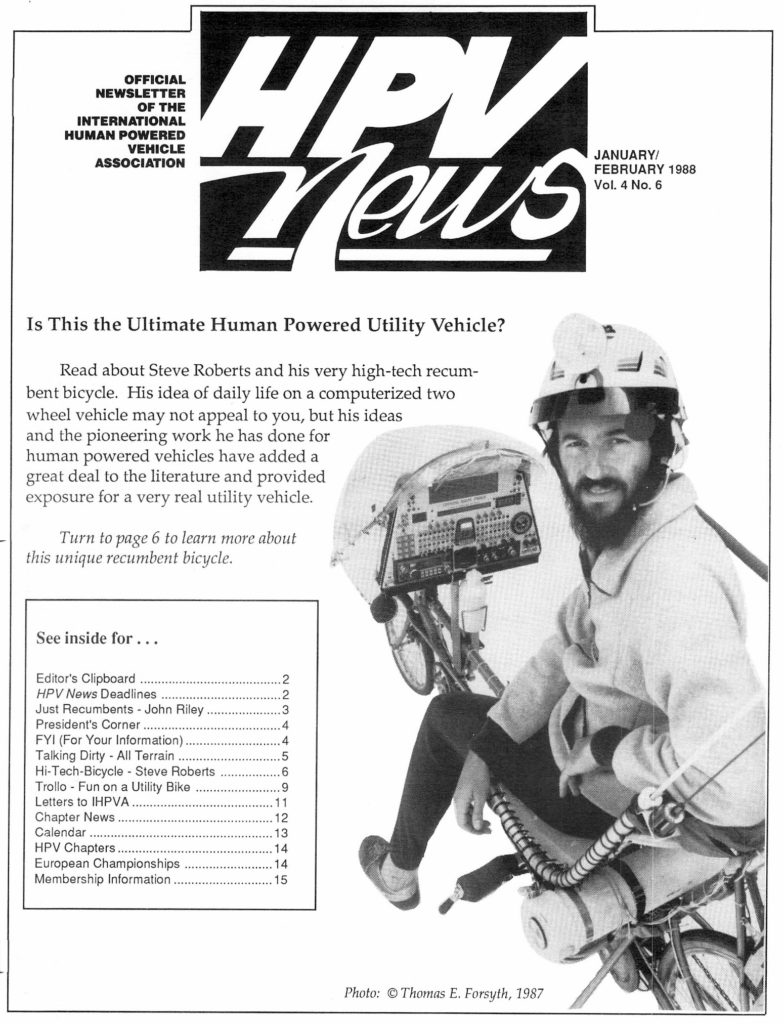
HPV News – Anatomy of a High-Tech Bicycle
by Steven K. Roberts
HPV News
January/February, 1988
Photo above: © Thomas E. Forsyth, 1987
Is This the Ultimate Human Powered Utility Vehicle?
Read about Steve Roberts and his very high-tech recumbent bicycle. His idea of daily life on a computerized two-wheel vehicle may not appeal to you, but his ideas and the pioneering work he has done for human powered vehicles have added a great deal to the literature and provided exposure for a very real utility vehicle.
[Editor’s note: Steve receives many questions about the various components of the Winnebiko. What follows is a menu choice from the GEnie CAA designed to provide a brief technical overview of his complex machine. The bold section headings are mine.]
Here, in no particular order, are the components of my electronic cottage on wheels:
Computers
My main computer is the Hewlett-Packard Portable PLUS, an exquisite system with 1.2 Megabytes of memory partitioned between system RAM and electronic disk. The high-contrast amber LCD displays 25 lines of 80 characters, and a built-in 1200 baud modem makes the daily GEnie check-ins easy. But what really sells the machine are the applications software packages baked into ROM: Microsoft WORD, Lotus 1-2-3, dbase II, a “card-manager” filing system, communications software, time manager, and a whole library of utilities. The net effect is a robust bicycle business system that runs on rechargeable batteries and weighs 8 pounds — a system that has become so much a part of my daily reality that I’m incapable of imagining nomadic life without it. It rides behind me, nestled in foam along with a 3.5-inch disk drive, sometimes accepting charge current from the bike’s solar panels.
Computer number two, built into the control console, was once a Radio Shack Model 100 — upgraded to 512K and made truly useful through the addition of Traveling Software’s Ultimate ROM and “Booster Pak” RAMdisk system. But the machine is now hardly recognizable: its keyboard and case are gone, and the display appears on the bike’s front panel behind a Lexan window. What happened to the keyboard? It has been replaced by custom logic that passes converted handlebar keycodes or software-generated commands. This system is intended for on-the-road text capture (not final editing), and thus connects with the HP via a front-panel RS-232 connector.
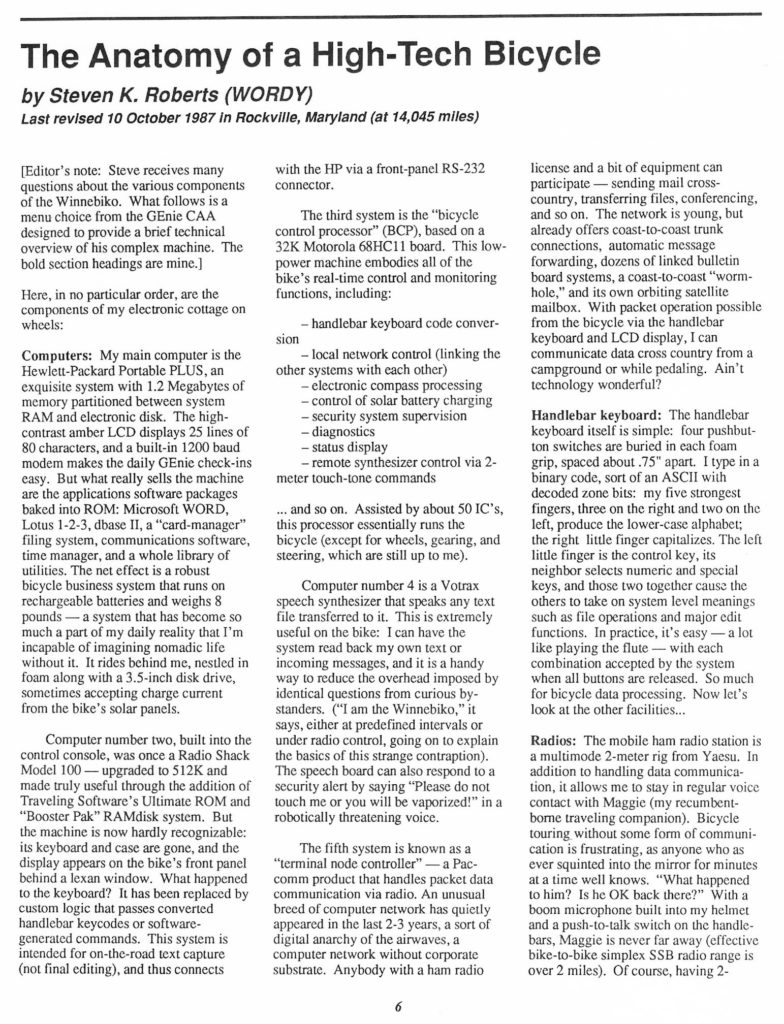
The third system is the “bicycle control processor” (BCP), based on a 32K Motorola 68HC11 board. This low-power machine embodies all of the bike’s real-time control and monitoring functions, including:
- handlebar keyboard code conversion
- local network control (linking the other systems with each other)
- electronic compass processing
- control of solar battery charging
- security system supervision
- diagnostics
- status display
- remote synthesizer control via 2-meter touch-tone commands
… and so on. Assisted by about 50 IC’s, this processor essentially runs the bicycle (except for wheels, gearing, and steering, which are still up to me).
Computer number 4 is a Votrax speech synthesizer that speaks any text file transferred to it. This is extremely useful on the bike: I can have the system read back my own text or incoming messages, and it is a handy way to reduce the overhead imposed by identical questions from curious bystanders. (“I am the Winnebiko,” it says, either at predefined intervals or under radio control, going on to explain the basics of this strange contraption). The speech board can also respond to a security alert by saying “Please do not touch me or you will be vaporized!” in a robotically threatening voice.
The fifth system is known as a “terminal node controller” — a PacComm product that handles packet data communication via radio. An unusual breed of computer network has quietly appeared in the last 2-3 years, a sort of digital anarchy of the airwaves, a computer network without corporate substrate. Anybody with a ham radio license and a bit of equipment can participate — sending mail cross country, transferring files, conferencing, and so on. The network is young, but already offers trunk connections, automatic message forwarding, dozens of linked bulletin board systems, a coast-to-coast “wormhole,” and its own orbiting satellite mailbox. With packet operation possible from the bicycle via the handlebar keyboard and LCD display, I can communicate data cross country from a campground or while pedaling. Ain’t technology wonderful?
Handlebar keyboard
The handlebar keyboard itself is simple: four pushbutton switches are buried in each foam grip, spaced about .75″ apart. I type in a binary code, sort of an ASCII with decoded zone bits: my five strongest fingers, three on the right and two on the left, produce the lower-case alphabet; the right little finger capitalizes. The left little finger is the control key, its neighbor selects numeric and special keys, and those two together cause the others to take on system level meanings such as file operations and major edit functions. In practice, it’s easy — a lot like playing the flute — with each combination accepted by the system when all buttons are released. So much for bicycle data processing. Now let’s look at the other facilities…
Radios
The mobile ham radio station is a multimode 2-meter rig from Yaesu. In addition to handling data communication, it allows me to stay in regular voice contact with Maggie (my recumbent-borne traveling companion). Bicycle touring without some form of communication is frustrating, as anyone who as ever squinted into the mirror for minutes at a time well knows. “What happened to him? Is he OK back there?” With a boom microphone built into my helmet and a push-to-talk switch on the handlebars, Maggie is never far away (effective bike-to-bike simplex SSB radio range is over 2 miles). Of course, having 2-meter FM capability on the bike also connects me to a huge network of ham radio operators: I store the local repeater frequencies into the radio’s memory as I approach an area, and periodically identify myself as an incoming bicycle mobile. This has led to a number of interesting encounters and places to stay. And — through the repeaters — I can make telephone calls directly from the bike.
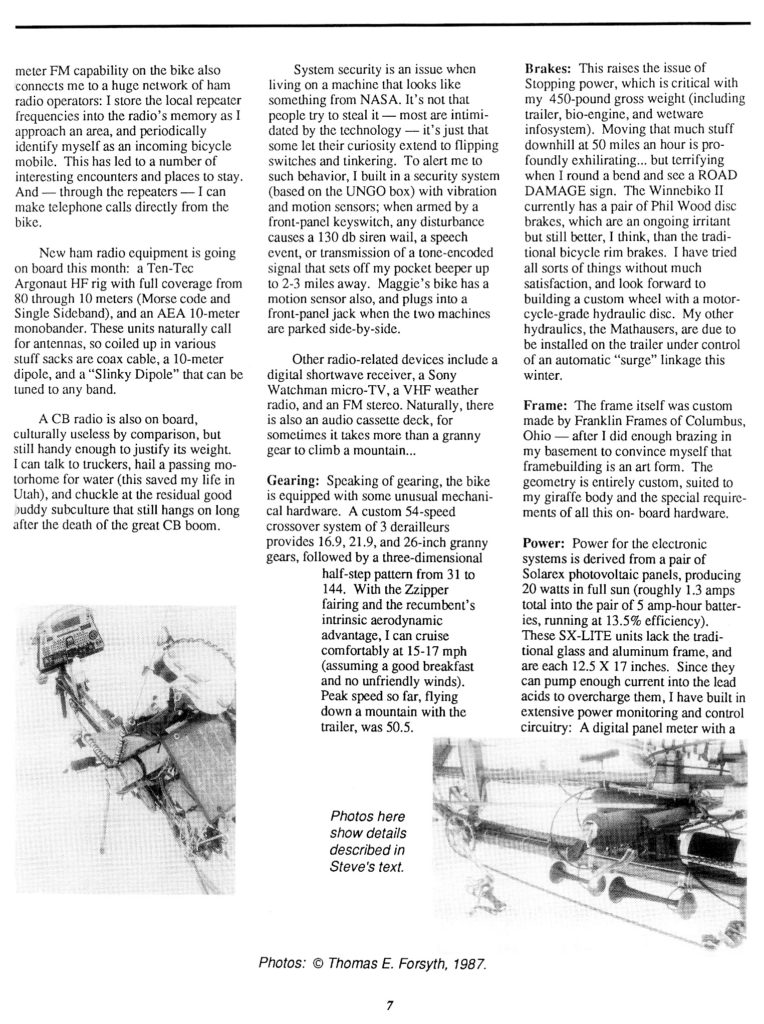
New ham radio equipment is going on board this month: a Ten-Tec Argonaut HF rig with full coverage from 80 through 10 meters (Morse code and Single Sideband), and an AEA 10-meter monobander. These units naturally call for antennas, so coiled up in various stuff sacks are coax cable, a 10-meter dipole, and a “Slinky Dipole” that can be tuned to any band.
A CB radio is also on board, culturally useless by comparison, but still handy enough to justify its weight. I can talk to truckers, hail a passing motorhome for water (this saved my life in Utah), and chuckle at the residual good-buddy subculture that still hangs on long after the death of the great CB boom.
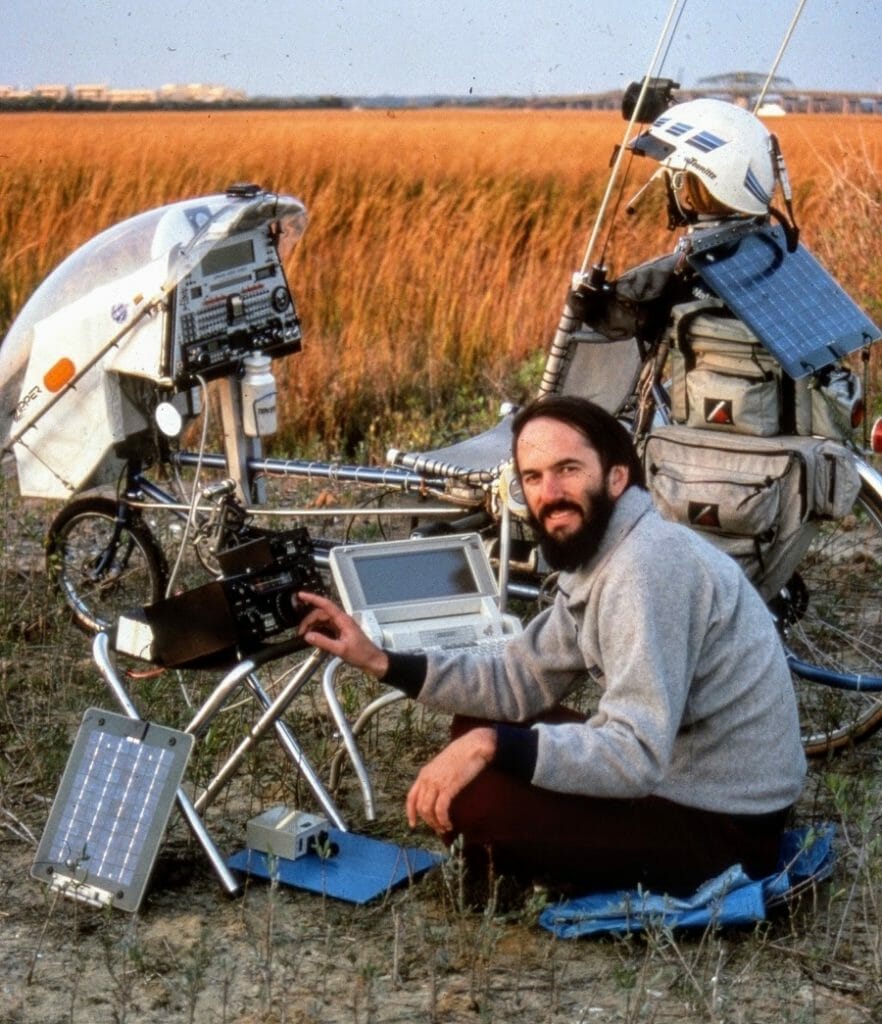
System security is an issue when living on a machine that looks like something from NASA. It’s not that people try to steal it — most are intimidated by the technology — it’s just that some let their curiosity extend to flipping switches and tinkering. To alert me to such behavior, I built in a security system (based on the UNGO box) with vibration and motion sensors; when armed by a front-panel keyswitch, any disturbance causes a 130 db siren wail, a speech event, or transmission of a tone-encoded signal that sets off my pocket beeper up to 2-3 miles away. Maggie’s bike has a motion sensor also, and plugs into a front-panel jack when the two machines are parked side-by-side.
Other radio-related devices include a digital shortwave receiver, a Sony Watchman micro-TV, a VHF weather radio, and an FM stereo. Naturally, there is also an audio cassette deck, for sometimes it takes more than a granny gear to climb a mountain…
Gearing
Speaking of gearing, the bike is equipped with some unusual mechanical hardware. A custom 54-speed crossover system of 3 derailleurs provides 16.9, 21.9, and 26-inch granny gears, followed by a three-dimensional half-step pattern from 31 to 144. With the Zzipper fairing and the recumbent’s intrinsic aerodynamic advantage, I can cruise comfortably at 15-17 mph (assuming a good breakfast and no unfriendly winds). Peak speed so far, flying down a mountain with the trailer, was 50.5.
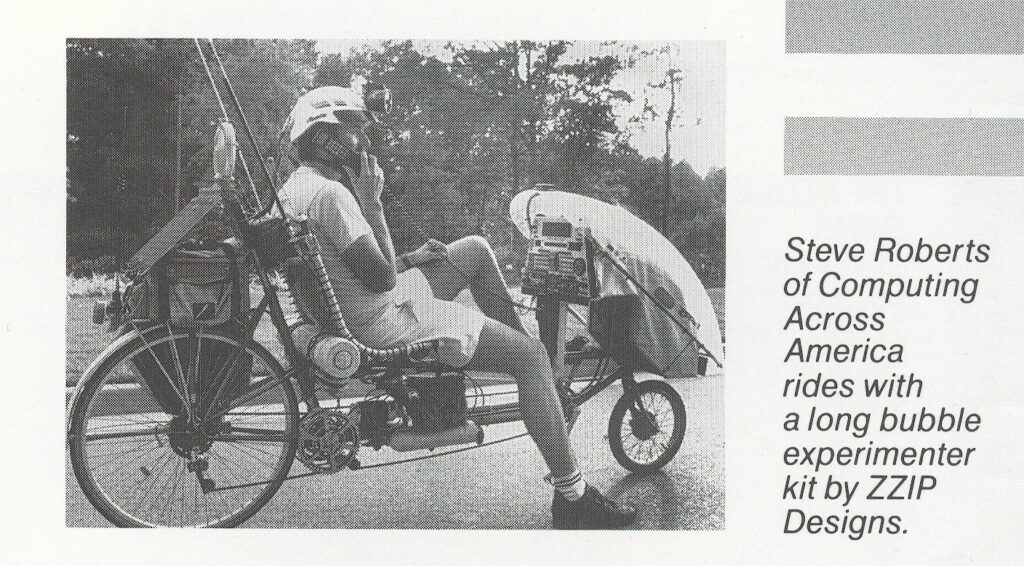
Brakes
This raises the issue of Stopping power, which is critical with my 450-pound gross weight (including trailer, bio-engine, and wetware infosystem). Moving that much stuff downhill at 50 miles an hour is profoundly exhilarating… but terrifying when I round a bend and see a ROAD DAMAGE sign. The Winnebiko II currently has a pair of Phil Wood disc brakes, which are an ongoing irritant but still better, I think, than the traditional bicycle rim brakes. I have tried all sorts of things without much satisfaction, and look forward to building a custom wheel with a motor cycle-grade hydraulic disc. My other hydraulics, the Mathausers, are due to be installed on the trailer under control of an automatic “surge” linkage this winter.
Frame
The frame itself was custom made by Franklin Frames of Columbus, Ohio — after I did enough brazing in my basement to convince myself that framebuilding is an art form. The geometry is entirely custom, suited to my giraffe body and the special requirements of all this on-board hardware.
Power
Power for the electronic systems is derived from a pair of Solarex photovoltaic panels, producing 20 watts in full sun (roughly 1.3 amps total into the pair of 5 amp-hour batteries, running at 13.5% efficiency). These SX-LITE units lack the traditional glass and aluminum frame, and are each 12.5 X 17 inches. Since they can pump enough current into the lead acids to overcharge them, I have built in extensive power monitoring and control circuitry: A digital panel meter with a thumbwheel switch can show instantaneous current into or out of each battery (as well as any system bus voltage), and the BCP can throttle back the charging process if its calculations indicate that the batteries are full (% charge values can be displayed on the console, but this turns out to be useless since the processor, usually off, gets out of sync with the batteries).
Other voltages besides the two 12-volt main buses are needed throughout the system, and this is one of those areas that can cause significant overhead if attention isn’t paid to losses. There is a small aluminum box containing LT1070-based switching supplies that coolly provide 3, 5, 6, 9, and -12 volts (all available on the front panel for external accessories). Considering the special requirements of a bicycle system, the extra design effort here has paid off well: when the two processors required for bike monitoring and text editing are active, total system current drain is only 130 milliamps. A sixth power supply, unrelated to the others, is mounted up front with a coiled cord to allow battery charging if I have gone too long without sunshine. (Tech details of the power system are here.)
Front panel
Instrumentation on the front panel is largely geared to the major electronic systems already described, but there is also the obligatory Cat-Eye Solar to display speed, distance, cadence, and so on. This elicits interesting comments from fellow bikies, who stare at the machine in awe then suddenly recognize something familiar. In addition, there is an altimeter (useful on mountains, and also helpful in predicting weather conditions), an Etak electronic compass, time/temperature display, and assorted system status indicators.
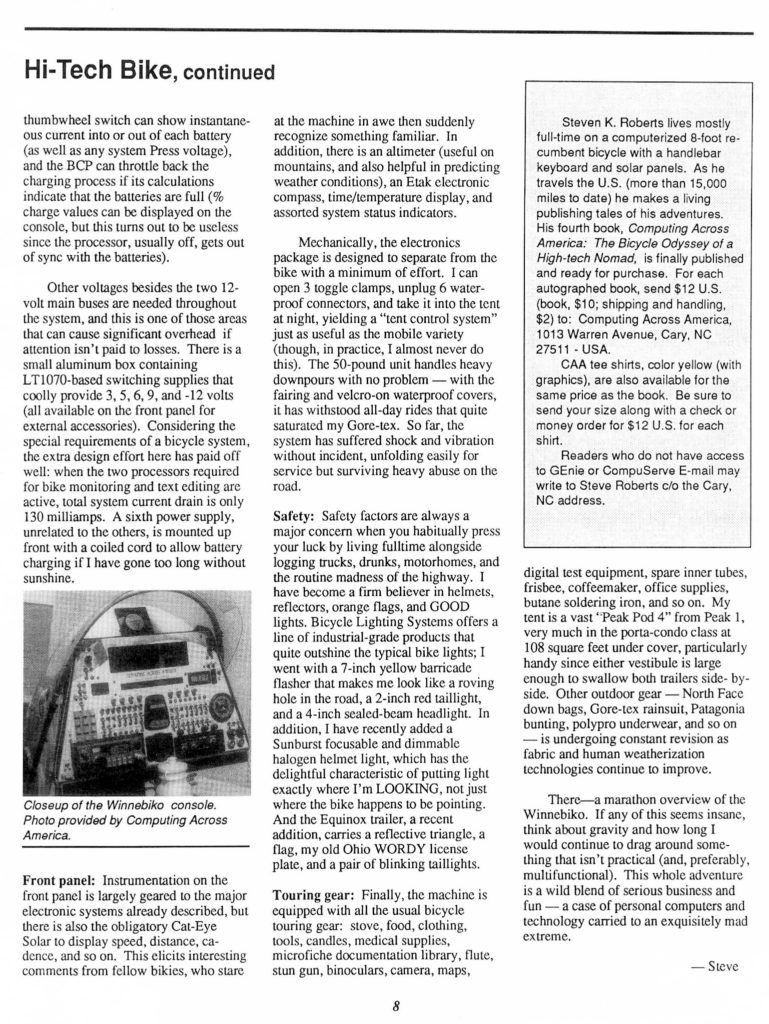
Mechanically, the electronics package is designed to separate from the bike with a minimum of effort. I can open 3 toggle clamps, unplug 6 waterproof connectors, and take it into the tent at night, yielding a “tent control system” just as useful as the mobile variety (though, in practice, I almost never do this). The 50-pound unit handles heavy downpours with no problem — with the fairing and velcro-on waterproof covers, it has withstood all-day rides that quite saturated my Gore-tex. So far, the system has suffered shock and vibration without incident, unfolding easily for service but surviving heavy abuse on the road. (Details of console fabrication are here.)
Safety
Safety factors are always a major concern when you habitually press your luck by living full time alongside logging trucks, drunks, motorhomes, and the routine madness of the highway. I have become a firm believer in helmets, reflectors, orange flags, and GOOD lights. Bicycle Lighting Systems offers a line of industrial-grade products that quite outshine the typical bike lights; I went with a 7-inch yellow barricade flasher that makes me look like a roving hole in the road, a 2-inch red taillight, and a 4-inch sealed-beam headlight. In addition, I have recently added a Sunburst focusable and dimmable halogen helmet light, which has the delightful characteristic of putting light exactly where I’m LOOKING, not just where the bike happens to be pointing. And the Equinox trailer, a recent addition, carries a reflective triangle, a flag, my old Ohio WORDY license plate, and a pair of blinking taillights.
Touring gear
Finally, the machine is equipped with all the usual bicycle touring gear: stove, food, clothing, tools, candles, medical supplies, microfiche documentation library, flute, stun gun, binoculars, camera, maps, digital test equipment, spare inner tubes, frisbee, coffeemaker, office supplies, butane soldering iron, and so on. My tent is a vast “Peak Pod 4” from Peak 1, very much in the porta-condo class at 108 square feet under cover, particularly handy since either vestibule is large enough to swallow both trailers side-by-side. Other outdoor gear — North Face down bags, Gore-tex rainsuit, Patagonia bunting, polypro underwear, and so on — is undergoing constant revision as fabric and human weatherization technologies continue to improve.
There — a marathon overview of the Winnebiko. If any of this seems insane, think about gravity and how long I would continue to drag around something that isn’t practical (and, preferably, multifunctional). This whole adventure is a wild blend of serious business and fun — a case of personal computers and technology carried to an exquisitely mad extreme.
(NOTE: this also ran in the Nashua Area Radio Club Bulletin – split between June and July issues, 1987)


You must be logged in to post a comment.